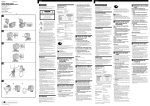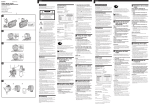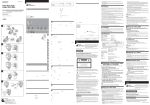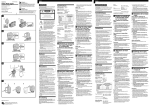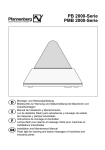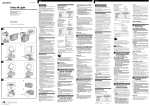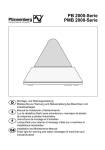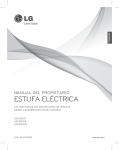Download Sony HVL-F5DF User's Manual
Transcript
3-078-474-01 (1) A-1 A A-1 A-2 A-2 B A-3 Video Flash Light /Operating Instructions/ Mode d’emploi/Manual de instrucciones 1 HVL-F5DF Sony Corporation © 2002 Printed in Japan You are cautioned that any changes or modifications not expressly approved in this manual could void your authority to operate this equipment. Features • • When attached to a camcorder this unit functions as a video light and flash. • Video light ON/OFF is controlled by the POWER mode switch of the camcorder. • The video flash can only be used on a camcorder with the PHOTO recording function. As the brightness of the flash is automatically adjusted according to the distance of the subjects, your picture does not become whitish with too much brightness. 1 2 • A ON OFF • POWER OFF Precautions POWER DC 6 V 5W 200cd Caution for heat OFF Be careful not to touch the lighting section because the glass window and surrounding surfaces are hot while the light is on and just after it is turned off. 1 20 POWER A ON NP-FF50 NP-FF70 40 90 2 1m 200 2m 50 3m 20 3 000K 100 B • • 1 500 14 5 500K NO. 3 LANC LANC 5.5 W 45 × 77 × 64 mm / / 100g 1 LANC 1 2 3 4 1 XB-5DX POWER OFF LANC LANC 1 5 After use • 1 • • • • • Set the power switch to OFF. • Make sure the video flash light has cooled down before storing it. Be sure to remove the battery pack when the video flash light is not in use or stored in its case, etc. English On cleaning WARNING Clean the video flash light with a dry soft cloth. You can remove stubborn stains with a cloth lightly dampened with a mild detergent solution, then dry the unit with a soft cloth. Never use strong solvents, such as thinner or benzine, since these will damage the finish on the surface. To prevent fire or shock hazard, do not expose the unit to rain or moisture. To avoid electrical shock, do not open the cabinet. Refer servicing to qualified personnel only. m • Never look directly at the bulb while the video light or flash is on. • Avoid placing the video flash light near combustible or volatile solvents such as alcohol or benzine. • Do not let any solid object or liquid fall onto or into the video flash light. • Do not knock or jolt the video flash light while it is turned on as it may damage or shorten the life of the bulb. • Do not leave the video light on while it is resting on or against something; it may cause a fire or damage the video flash light. • Do not pick up the camcorder by the head of the video flash light. • Remove the video flash light before putting the camera into a carrying case. • Do not place anything over the ventilation grill. • When the cover is hot do not allow it to get wet. • Do not leave the power switch of the video flash light on when it is not in use. • Do not turn the video flash light on without attaching the front cover. • If battery voltage drops to a certain level, the video flash light may not function suddenly. This is not a malfunction. In this case, turn off the power, then charge the battery pack again or use another fully charged battery pack. • When the front cover is hot, do not allow it to get wet. Otherwise, the video flash light may be damaged, or personal injury could result. • Do not place the video flash light in the following locations as it may be damaged or deformed: - extremely high temperature, such as in a car parked in the sun - directly in the sun, or near a heater - extreme vibration • • This symbol is intended to alert the user to the presence of uninsulated “dangerous voltage” within the product’s enclosure that may be of sufficient magnitude to constitute a risk of electric shock to persons. • POWER • • • • 0564-62-4979 9 5 HVLF5DF • POWER • OFF OFF This symbol is intended to alert the user to the presence of important operating and maintenance (servicing) instructions in the literature accompanying the appliance. NOTE This equipment has been tested and found to comply with the limits for a Class B digital device, pursuant to Part 15 of the FCC Rules. These limits are designed to provide reasonable protection against harmful interference in a residential installation. This equipment generates, uses, and can radiate radio frequency energy and, if not installed and used in accordance with the instructions, may cause harmful interference to radio communications. However, these is no guarantee that interference will not occur in a particular installation. If this equipment does cause harmful interference to radio or television reception, which can be determined by turning the equipment off and on, the user is encouraged to try to correct the interference by one or more of the following measures: — Reorient or relocate the receiving antenna. — Increase the separation between the equipment and receiver. — Connect the equipment into an outlet on a circuit different from that to which the receiver is connected. — Consult the dealer or an experienced radio/TV technician for help. 6 V DC 5W Approx. 200 cd Horizontal 20 degrees Type of battery pack Lighting duration NP-FF50 40 NP-FF70 90 (Approx. minutes using fully-charged battery pack) Illumination range Color temperature Average life of bulb Approx. 1 m (3 1/5 ft) 200 lux, Approx. 2 m (6 1/2 ft) 50 lux, Approx. 3 m (9 4/5 ft) 20 lux 3 000 K Approx. 100 hours Video flash segment Flash life Guide no. Color temperature Approx. 1 500 times equivalent to 14 (Memory Photo recording) 5 500 K Others Power consumption Dimensions (excluding projecting parts) Mass Accessories (supplied) Accessory (not supplied) Using the shoe adapter 1 Attach the shoe adapter to the tripod receptacle of the camcorder. Turn the knob of the shoe adapter in the direction of the arrow to tighten firmly. A The guide marks to attach the camcorder to the shoe adapter. 2 Attach the video flash light to the shoe adapter. Make sure that the lighting section faces to the front and slide it firmly into the shoe adapter. You can turn the attached video flash light to the desired direction. Point the video flash light in the desired direction. Turn the lock knob in the direction of the arrow to tighten. B The point to adjust the direction of the video flash light. •Attach the video flash light in parallel with the camcorder when recording with the video flash. •Turn the video flash light to illuminate the central area of pictures when recording with the video light. 3 Connect the LANC cable. Connect the LANC cable of the video flash light to the LANC jack of the camcorder. Removing the video flash light 1 2 3 4 5 Set the power switch of the video flash light to OFF. Remove the LANC cable from the LANC jack of the camcorder. Loosen the lock knob by turning it in the direction of the arrow 1. Remove the video flash light from the shoe adapter. Remove the shoe adapter from the camcorder. Notes • If you cannot insert the video flash light into the shoe adapter, turn the lock knob in the direction of the arrow 1 fully and insert the video flash light again. • Mount the video flash light correctly, observing the direction of the arrow on the shoe adapter. Français AVERTISSEMENT Afin d’éviter tout risque d’incendie ou d’électrocution, ne pas exposer cet appareil à la pluie ou à l’humidité. Afin d’écarter tout risque d’électrocution, garder le coffret fermé. Ne confier l’entretien de l’appareil qu’à un professionnel. Caractéristiques • Rattaché à un camescope, cet appareil sert de lampe et de flash vidéo. • La mise en marche ou l'arrêt (ON/OFF) de la lampe vidéo est contrôlée par l'interrupteur POWER du caméscope. • Le flash vidéo ne peut être utilisé qu’avec un camescope présentant le mode PHOTO. Comme la luminosité du flash est automatiquement ajustée en fonction de la distance du sujet, la photo ne risque pas d’être surexposée sous un éclairage lumineux. Attention à la chaleur Video light segment Power requirements Lamp Maximum luminous intensity Lighting direction Lighting angle Continuous lighting time Set the power switch of the video flash light to OFF before attaching it to the shoe adapter or your camcorder. If your camcorder has the accessory shoe for the video flash light, attach the video flash light directly to the accessory shoe. Use the supplied shoe adapter when the accessory shoe is not provided on the camcorder. Précautions Specifications 1 2 A Attaching the video flash light 5.5 W Approx. 45 × 77 × 64 mm (1 13/16 × 3 1/8 × 2 5/8 inches) (w/h/d) Approx. 100 g (3 1/2 oz.) Shoe adapter (1) Operating instructions Halogen lamp XB-5DX Design and specifications are subject to change without notice. Faites attention à ne pas toucher la section d'éclairage car la fenêtre en verre et les surfaces environnantes sont chaudes quand la lampe est allumée et juste après avoir été éteinte. • Ne jamais regarder directement l’ampoule quand la lampe ou le flash vidéo sont allumés. • Evitez de poser la lampe-flash vidéo près de combustibles ou de solvants volatils, comme l’alcool ou la benzine. • Veillez à ne pas laisser tomber de solide ni de liquide sur ou dans la lampe-flash vidéo. • Ne pas cogner ni secouer la lampe-flash vidéo quand elle est éclairée afin de ne pas l’endommager ou de ne pas réduire la durée de vie de l’ampoule. • Ne pas laisser la lampe-flash vidéo allumée quand elle est posée sur ou contre quelque chose. Il y a risque d’incendie ou la lampe pourrait être endommagée. • Ne pas saisir le camescope par la lampe-flash vidéo. • Enlevez la lampe-flash vidéo avant de ranger le camescope dans sa sacoche de transport. • Ne rien poser sur la grille de ventilation. • Quand le capot de la lampe est trop chaud, ne pas le mouiller. • Ne laissez pas l'interrupteur d'alimentation de la lampe flash-vidéo sur ON si vous ne l'utilisez pas. • N'allumez pas la lampe flash-vidéo sans fixer le cache avant. • Si la tension de la pile chute à un certain niveau, la lampe flash-vidéo peut cesser de fonctionner tout à coup. Il ne s'agit pas d'un dysfonctionnement. Dans ce cas, mettez la lampe hors tension, puis rechargez le bloc batterie ou utilisez un autre bloc entièrement rechargé. • Si le cache avant est chaud, ne le mouillez pas. Sinon, vous risquez d'endommager la lampe flash-vidéo ou de vous blesser. • N'installez pas la lampe flash-vidéo dans les endroits suivants car elle risque de s'abîmer ou de se déformer : - endroits soumis à une température très élevée, comme une voiture stationnée en plein soleil - en plein soleil ou à proximité d'un appareil de chauffage - endroits soumis à de fortes vibrations. Après utilisation • Réglez l’interrupteur d’alimentation sur OFF. • Assurez-vous que la lampe-flash vidéo s'est refroidie avant de la ranger. Lorsque vous n'utilisez pas la lampe flash-vidéo ou que celle-ci est rangée dans son boîtier, enlevez le bloc batterie. Otros Español ADVERTENCIA Para evitar incendios o descargas eléctricas, no exponga la unidad a la lluvia ni a la humedad. Para evitar descargas eléctricas, no abra la unidad. En caso de avería, solicite los servicios de personal cualificado. Nettoyage Nettoyez la lampe-flash vidéo avec un chiffon doux et sec. Vous pouvez enlever les tâches rebelles avec un chiffon légèrement imprégné de détergent neutre, puis essuyez la lampe avec un chiffon doux. Ne jamais utiliser de solvants puissants, tel qu’un diluant ou de la benzine, car ils peuvent endommager la finition. Spécifications Section Lampe vidéo Alimentation Lampe Intensité lumineuse maximale Direction d’éclairage Angle d’éclairage Temps d’éclairage continu 6 V CC 5W Env. 200 cd Horizontale 20 degrés Type de batterie rechargeable Temps d’éclairage NP-FF50 40 NP-FF70 90 (Env. en minutes avec une batterie rechargeable pleine) Env. 1 m (3 1/5 ft) 200 lux, Env. 2 m (6 1/2 ft) 50 lux, Env. 3 m (9 4/5 ft) 20 lux Température de couleur 3 000 K Durée de vie moyenne de l’ampoule Env. 100 heures Plage d’illumination El diseño y las especificaciones están sujetos a cambio sin previo aviso. Características • Fijada a una videocámara, esta unidad funcionará como lámpara para vídeo y como flash. • La lámpara para vídeo se activa y desactiva (ON/OFF) mediante el interruptor POWER de la videocámara. • El flash para vídeo solamente podrá utilizarse con una videocámara con función de videofilmación PHOTO. Como el brillo del flash se ajusta automáticamente de acuerdo con la distancia hasta el motivo, es posible que sus imágenes no resulten blanquecinas con demasiado brillo. Precauciones Precauciones para evitar el recalentamiento Tenga cuidado de no tocar la sección de iluminación porque la ventanilla de cristal y las superficies circundantes estarán calientes cuando la lámpara esté encendida e inmediatamente después de haberla apagado. Réglez l'interrupteur d'alimentation de la lampe-flash vidéo sur OFF avant de la fixer sur la griffe porteaccessoires ou le caméscope. Si le caméscope possède un porte-accessoires pour la lampe-flash vidéo, fixez celle-ci directement sur la griffe porte-accessoires. Utilisez la griffe porte-accessoires fournie si le porteaccessoires n'est pas fourni avec le caméscope. • No mire directamente hacia la bombilla cuando la lámpara/flash para vídeo esté encendida. • Evite colocar la lámpara/flash para vídeo cerca de combustibles o disolventes volátiles, como alcohol o bencina. • No permita que dentro de la lámpara/flash para vídeo entre ningún objeto sólido ni líquido. • No golpee ni sacuda la lámpara/flash para vídeo mientras esté encendida, ya que podría dañarla o acortar la duración de la bombilla. • No deje la lámpara/flash para vídeo encendida sobre ni apoyada contra nada, porque podría provocar un incendio o dañarla. • No tome la videocámara por la cabeza de la lámpara/ flash para vídeo. • Quite la lámpara/flash para vídeo antes de colocar la videocámara en una caja de transporte. • No coloque nada sobre la rejilla de ventilación. • Cuando la cubierta esté caliente, no permita que se humedezca. • Apague el interruptor de alimentación de la lámpara/ flash para vídeo cuando no la utilice. • Monte la cubierta frontal antes de encender la lámpara/ flash para vídeo. • Si el voltaje de la batería desciende hasta un determinado nivel, es posible que la lámpara/flash para vídeo deje de funcionar de forma repentina. No se trata de un error de funcionamiento. Si esto sucede, apague la alimentación y vuelva a cargar la batería o utilice otra batería totalmente cargada. • Si la cubierta frontal está caliente, evite que se moje. De lo contrario, pueden producirse lesiones físicas o daños en la lámpara de flash para vídeo. • Para evitar que la lámpara/flash para vídeo se dañe o se deforme, evite colocarla en lugares: - expuestos a temperaturas extremadamente altas, como en un automóvil estacionado al sol - expuestos a la luz solar directa o cerca de un calefactor - expuestos a vibraciones muy fuertes Utilisation de la griffe porte-accessoires Después de la utilización 1 • Ponga el interruptor de alimentación en OFF. • Asegúrese de que la lámpara/flash para vídeo se ha enfriado antes de almacenarla. Section Flash vidéo Durée de vie du flash Nombre guide Température de couleur Env. 1 500 éclairs Equivalent à 14 (Enregistrement de photos dans la mémoire) 5 500 K Divers Consommation Dimensions (parties saillantes non comprises) Poids Accessoires (fournis) Accessoire (non fourni) 5.5 W Env. 45 × 77 × 64 mm (1 13/16 × 3 1/8 × 2 5/8 po.) (l/h/d) Env. 100 g (3 1/2 on.) Griffe porte-accessoires (1) Mode d’emploi (1) Lampe halogène XB-5DX La conception et les spécifications peuvent être modifiées sans avis préalable. A Fixation de la lampe flash-vidéo Fixez la griffe porte-accessoires à la douille du trépied du caméscope. Tournez la bague de la griffe porte-accessoires dans le sens de la flèche pour la bloquer. A Repères pour fixer le caméscope sur la griffe porteaccessoires. 2 Fixez la lampe flash-vidéo sur la griffe porteaccessoires. Vérifiez que la partie éclairante est bien orientée vers l'avant et glissez-la fermement dans la griffe porteaccessoires. Vous pouvez orienter la lampe-flash vidéo dans la direction de votre choix. Orientez la lampe flash-vidéo dans la direction souhaitée. Tournez la bague de blocage dans le sens de la flèche pour la bloquer. B Point pour ajuster l'orientation de la lampe-flash vidéo. •Fixez la lampe-flash vidéo parallèlement au caméscope lorsque vous enregistrez avec le flash vidéo. •Tournez la lampe-flash vidéo pour éclairer la zone centrale des images lorsque vous enregistrez avec la lampe vidéo. 3 Branchement du câble LANC. Branchez le câble LANC de la lampe flash-vidéo à la prise LANC du caméscope. Pour enlever la lampe-flash vidéo 1 2 3 4 5 Réglez l'interrupteur d'alimentation de la lampe vidéo sur OFF. Débranchez le câble LANC de la prise LANC du caméscope. Desserrez la bague de blocage en la tournant dans le sens de la flèche 1. Retirez la lampe flash-vidéo de la griffe porteaccessoires. Retirez la griffe porte-accessoires du caméscope. Remarques • Si vous ne parvenez pas à insérer la lampe-flash vidéo dans la griffe porte-accessoires, tournez la bague de blocage complètement dans le sens de la flèche 1 puis réinsérez la lampe-flash vidéo. • Montez correctement la lampe-flash vidéo, en respectant le sens de la flèche sur la griffe porteaccessoires. Retire la batería cuando no utilice la lámpara/flash para vídeo o cuando la guarde en su estuche, etc. Limpieza Limpie la lámpara/flash para vídeo con un paño suave y seco. Usted podrá eliminar las manchas difíciles con un paño ligeramente humedecido en una solución muy diluida de detergente, y después secándola con un paño suave. No utilice nunca disolventes fuertes, como diluidor de pintura o bencina, ya que podrían dañar el acabado de la superficie. Especificaciones Segmento de la lámpara para vídeo Alimentación Bombilla Intensidad luminosa máxima Dirección de iluminación Ángulo de iluminación Tiempo de iluminación continua 6 V CC 5W Aprox. 200 candelas Horizontal 20 grados Tipo de batería Duración de iluminación NP-FF50 40 NP-FF70 90 (Minutos aproximados utilizando una batería completamente cargada) Alcance de iluminación Temperatura de color Duración media de la bombilla Aprox. 1 m, 200 lux, Aprox. 2 m, 50 lux, Aprox. 3 m, 20 lux 3 000 K Aprox. 100 horas Segmento del flash para vídeo Duración del flash Número guía Temperatura de color Consumo 5.5 W Dimensiones Aprox. 45 × 77 × 64 mm (excluyendo las partes (an/al/prf) salientes) Masa Aprox. 100 g Accesorios (suministrados) Adaptador para zapata (1) Manual de instrucciones (1) Accesorio (no suministrado) Bombilla halógena XB-5DX Aprox. 1 500 veces Equivalente a 14 (Grabación de fotos en la memoria) 5 500 K A Montaje de la lámpara/ flash para vídeo Ajuste el interruptor de alimentación de la lámpara/flash para vídeo en OFF antes de colocarla en el adaptador para zapata o la videocámara. Si la videocámara dispone de la zapata accesoria para la lámpara/flash para vídeo, instale dicha lámpara directamente en la zapata accesoria. Utilice el adaptador para zapata suministrado en el caso de que la zapata accesoria no se incluyese con la videocámara. Utilización del adaptador para zapata 1 Monte el adaptador para zapata en el receptáculo del trípode de la videocámara. Fije el adaptador para zapata girando el mando en el sentido de la flecha. A Marcas de la guía para unir el adaptador para zapata a la videocámara. 2 Monte la lámpara/flash para vídeo en el adaptador para zapata. Cerciórese de que la sección de destello quede encarada hacia adelante e introdúzcala con firmeza en el adaptador para zapata. Es posible girar la lámpara/flash para vídeo instalada hacia la dirección deseada. Oriente la lámpara/flash para vídeo en el sentido deseado. Gire el mando de bloqueo en el sentido de la flecha para fijarlo. B Punto donde ajustar la dirección de la lámpara/ flash para vídeo. •Coloque la lámpara/flash para vídeo de modo que quede paralela a la videocámara cuando utilice el flash para vídeo para grabar. •Gire la lámpara/flash para vídeo para iluminar el área central de las imágenes cuando grabe con dicha lámpara. 3 Conecte el cable LANC. Conecte el cable LANC de la lámpara/flash para vídeo en la toma LANC de la videocámara. Para desmontar la lámpara/flash para vídeo 1 2 3 4 5 Ponga el interruptor de alimentación de la lámpara para vídeo en OFF. Desenchufe el cable LANC de la toma LANC de la videocámara. Afloje el mando de bloqueo girándolo en el sentido de la flecha 1. Retire la lámpara/flash para vídeo del adaptador para zapata. Retire el adaptador para zapata de la videocámara. Notas • Si no puede insertar la lámpara/flash para vídeo en el adaptador para zapata, gire por completo el mando de bloqueo en el sentido de la flecha 1 e inserte de nuevo la lámpara/flash para vídeo. • Coloque la lámpara/flash para vídeo correctamente, siguiendo el sentido de la flecha del adaptador para zapata. C B E D F-1 1 1 F-2 F-3 READY 2 LIGHT LIGHT OFF ON OFF ON a 1 • D Using the video light c POWER OFF B 2 2 E • • • • Control the video light with the camcorder in standby mode 1 Set the camcorder POWER switch to ON. 2 Set the power switch to LIGHT ON, pressing the green button in the direction of the arrow 1 to turn on the video light. 3 Turn on/off the camcorder. The video light is turned on/off in sync with the camcorder. 1 • • POWER OFF • • 1 After use Set the power switch to OFF. 10 Note Make sure the video light has cooled down before storing it. - C DCR-IP220 E Installing the battery pack - 10 30 Use the battery pack NP-FF50/FF70. 1 Set the power switch of the video flash light to OFF. 2 Install the battery pack until it clicks, aligning the terminal of the battery pack with the terminal of the video flash light. AC removing the battery pack F 1 2 1 2 XB-5DX POWER 1 ON READY READY • • • 1 1 2 3 HVL-F5DF English 2 B Lighting up a subject • When recording indoors with this unit, you can get clear and beautiful color pictures. • For wide angle shots, the video light may not light the corners of pictures completely. Use the video light for shooting the main subject of the picture effectively. • When bright light shines from behind the subject (backlighting), the video light is very effective for lighting up the main part of the subject, such as the person’s face. Outdoors, be sure that you do not stand facing the sun. • Fluorescent lights tend to produce flickering in the recording. Use of the video flash light may help to produce better pictures with less color blur. 3 READY 1 2 • • 4 • C Using the video flash • POWER OFF • 1 5m • A OFF OFF • POWER ON POWER OFF c OFF ON OFF D ON 1 LANC ON 2 POWER ON POWER LIGHT ON 1 3 ON/OFF OFF / POWER POWER ON LANC OFF POWER OFF LANC POWER ON/ OFF / Use the video flash only with a camcorder which has the PHOTO recording function. The DCR-IP220/IP210 is the model used for illustration purposes. For details, refer to the operating instructions of your camcorder. (The instructions below show the operations when the camcorder POWER switch is set to CAMERA. However you can also use the video flash light when the power switch is set to MEMORY.) 1 Set the camcorder POWER switch to CAMERA. pressing the green button 2 Slide the power switch to in the direction of the arrow 1 to set the power switch of the video flash light to ON. The charge complete lamp READY blinks as the video flash light starts to charge. When charging is complete, the charge complete lamp READY stops blinking but remains on. 3 Keep pressing the camcorder PHOTO button lightly to confirm the image. Keep the camcorder PHOTO button pressed down lightly. The flashing of the video flash light is linked to the PHOTO button. A still picture appears in the viewfinder and the memory indicator comes on. Recording is not carried out at this point. To change the still picture, release the camcorder PHOTO button. The video flash light starts charging again after you release the camcorder PHOTO button. Wait until the battery charge complete lamp READY appears before lightly pressing the PHOTO button again. Because the camcorder automatically adjusts the brightness when you press the PHOTO button, the image may get darker or the colors may seem to change. 4 Press the camcorder PHOTO button deeper. When you press the PHOTO button, the bar scroll indicator disappears and recording stops. During recording, captured images appear in the viewfinder or on the LCD. When you release the PHOTO button, the video flash light automatically starts to recharge after the image is recorded. After use LED E NP-FF50/FF70 1 Set the power switch to OFF. l POWER OFF 2 LED • c • c 2 1 1 1 2 POWER ON POWER ON Notes • The appropriate distance between a subject and the video flash light is approx. 1 m to 5 m in a dark room. • During recording, keep your fingers away from the sensor A of this unit. Otherwise, the brightness of the flash cannot be adjusted properly. • The video flash light will be recharged even if it is completely charged after: - you set the power switch to OFF. - you set the camcorder POWER switch to OFF. Set the power switch of the video flash light to OFF. Pressing down the battery release lever in the direction of the arrow 1, remove the battery pack in the direction of the arrow 2. (see illustration E) Note • Be sure to turn the power switch OFF when installing or removing the battery pack. • Battery pack performance decreases in low-temperature surroundings (lower than 10˚C) so that the time the battery pack can be used becomes shorter. We recommend the following to use the battery pack longer: - Put the battery pack in a pocket to warm it up, and insert it in your video flash light immediately before you start taking shots. - We recommend charging the battery pack (by attaching to the AC adapter) in an ambient temperature of between 10˚C to 30˚C (50°F to 86°F). F Replacing the bulb Use the Sony XB-5DX halogen lamp (optional). The bulb is hot when it has just burned out. Wait until the bulb cools down before removing it. 1 Remove the front cover after making sure that the unit is cool enough to handle. Push in the direction of 1 to loosen the lock knob. Pull in the direction of 2 to remove the front cover. 2 When the bulb has cooled sufficiently, grasp it securely and pull it out to replace. Insert the new bulb into the socket straightly. 3 After the bulb has been inserted, attach the front cover straightly. Align the front cover with 1. Push 2 in the direction of the arrow until the knob is locked. Notes • The bulb is hot when it has just burned out. Make sure that the bulb is cool enough to handle. • To prevent the bulb from being smudged with fingerprints, handle it with a dry cloth. If the bulb is smudged, wipe it completely clean. • The interior of this unit contains high voltage, opening it can cause electrical shock. To inspect the unit’s interior, consult your nearest Sony dealer or Sony Service facility. Type of trouble and how to correct trouble If you run into any problem using your video flash light, use the following table to troubleshoot the problem. If the problem persists, turn the video flash light off and contact your Sony dealer or Sony Service facility. Symptom Cause and/or Corrective Action The video flash light lights up if the power switch is set to LIGHT ON while the power switch of your camcorder is set to OFF. When the power switch of your camcorder is set to OFF, the power switch of the video flash light is not interlocked with it. c To interlock the video flash light with your camcorder, turn on your camcorder, then turn off your camcorder. The video flash light is also turned off and is now interlocked. The video flash light goes out if you disconnect the LANC cable, although the power switch of the video flash light is set to LIGHT ON and your camcorder is turned on. This is not a malfunction. The video flash light remains turned on if you set the power switch of the video flash light to LIGHT ON and disconnect the LANC cable while the power switch of your camcorder is set to OFF. This is not a malfunction. To turn off the video flash light, set the power switch of the video flash light to OFF. When the LANC cable is not connected, set the power switch of the video flash light to LIGHT ON or OFF to turn on or off the light. LED indicator In Flash mode The indicator flashes l The indicator lights up (Charging) (Fully charged) In Light mode The indicator flashes (The battery is nearly dead) In the following instances the indicator flashes fast: • The battery is discharged. c Charge the battery fully. • The rating of the replaced halogen lamp is not correct. c Check the rating of the lamp. • Something is wrong with the battery pack. c Install a new battery pack. Français B Eclairage d’un sujet • Si vous filmez en intérieur avec la lampe vidéo, vous obtiendrez des images nettes avec de belles couleurs. • Lors de la prise de vues en grand angle, la lampe vidéo ne pourra peut-être pas éclairer complètement les angles de l’image. Utilisez la lampe vidéo pour bien éclairer et filmer le sujet principal de l’image. • Quand une lumière intense se trouve derrière le sujet (contre-jour), la lampe vidéo éclaire de manière efficace la partie principale du sujet, par exemple le visage d’une personne. A l’extérieur, veillez à ne pas filmer face au soleil. • Les lampes fluorescentes ont tendance à produire un vacillement de l’image. L’utilisation de la lampe vidéo peut améliorer les images en accentuant la netteté des couleurs. C Utilisation du flash vidéo Utilisez le flash vidéo seulement avec un camescope présentant le mode PHOTO. Les illustrations représentent le DCR-IP220/IP210. Pour les détails, consultez le mode d’emploi du camescope. (Les instructions ci-après montrent les opérations lorsque l'interrupteur POWER du caméscope est réglé sur CAMERA. Toutefois, vous pouvez également utiliser la lampe-flash vidéo lorsque l'interrupteur d'alimentation est réglé sur MEMORY.) 1 Réglez l'interrupteur POWER du caméscope sur CAMERA. 2 Faites glisser l'interrupteur d'alimentation vers en appuyant sur le bouton vert dans le sens de la flèche 1 afin de régler l'interrupteur d'alimentation de la lampe-flash vidéo sur ON. Le témoin de charge READY clignote pendant la recharge. Lorsqu’elle est terminée, le témoin READY cesse de clignoter et reste allumé. 3 Tenez la touche PHOTO du camescope légèrement enfoncée jusqu’à ce qu’une image apparaisse. Le fonctionnement de la lampe-flash vidéo est lié à l’activation de la touche PHOTO. Une image fixe apparaît dans le viseur et l’indicateur d’enregistrement en mémoire s’allume lorsque vous appuyez sur cette touche. L’enregistrement n’est pas encore exécuté à ce moment. Pour changer d’image, relâchez la touche PHOTO du camescope. Le flash vidéo se recharge aussitôt. Attendez que le témoin de charge READY apparaisse avant d’appuyer une nouvelle fois légèrement sur la touche PHOTO. La luminosité s’ajuste lorsque vous appuyez sur la touche PHOTO, et l’image peut paraître plus sombre ou les couleurs différentes à ce moment. 4 Appuyez plus fort sur la touche PHOTO du camescope. Lorsque vous appuyez sur la touche PHOTO, l’indicateur à barres disparaît et l’enregistrement s’arrête. Pendant l’enregistrement, les images saisies apparaissent dans le viseur ou sur l’écran LCD. Lorsque vous relâchez la touche PHOTO, la lampeflash vidéo se recharge dès que l’image est enregistrée. 2 Poussez le bloc batterie jusqu'à ce qu'il s'encliquette en alignant la borne du bloc batterie sur celle de la lampe-flash vidéo. Retrait du bloc batterie 1 2 Réglez l'interrupteur d'alimentation de la lampe-flash vidéo sur OFF. Appuyez sur l'ergot de dégagement de la batterie dans le sens de la flèche 1 puis retirez la batterie dans le sens de la flèche 2. (Voir l’illustration E) Remarques • Lors de la mise en place ou du retrait du bloc batterie, veillez à mettre l'interrupteur d'alimentation hors tension (OFF). • Les performances du bloc batterie diminuent dans des environnements à basses températures (inférieures à 10 °C) de sorte que le temps d'utilisation du bloc batterie décroît. Pour optimiser le temps d'utilisation du bloc batterie, nous vous recommandons de : - mettre le bloc batterie dans une poche pour le réchauffer et de l'insérer dans votre lampe flash-vidéo juste avant de faire des prises de vue. - Nous vous conseillons de charger le bloc batterie (en le fixant à l'adaptateur secteur) à une température ambiante située entre 10 °C et 30 °C (50 °F à 86 °F). F Remplacement de l’ampoule Utilisez une lampe halogène Sony XB-5DX (en option). L’ampoule est brûlante quand elle vient d’être éteinte. Laissez-la refroidir avant de l’enlever. 1 Enlevez le capot avant après avoir vérifié que la lampe était suffisamment froide. Poussez dans le sens de 1 pour desserrer le bague de serrage. Tirez dans le sens de 2 pour retirer le capot avec avant. 2 Quand l’ampoule est suffisamment froide, prenez-la avec précaution et tirez dessus. Insérez la nouvelle ampoule tout droit dans la douille. 3 Après avoir remplacé l’ampoule, remettez le capot tout droit sur la lampe. Alignez le capot avant sur 1. Poussez 2 dans le sens de la flèche jusqu’à ce que la bague soit serrée. Remarques • L’ampoule reste chaude un moment après avoir été éteinte. Assurez-vous que l’ampoule est suffisamment froide avant de la sortir. • Pour éviter de laisser des traces de doigts sur l’ampoule, tenez l’ampoule avec un chiffon sec. Si l’ampoule est sale, essuyez-la bien. • L’intérieur de la lampe contient un circuit haute tension. Afin d’éviter tout risque d’électrocution, ne pas ouvrir la lampe. Pour tout contrôle interne, consultez votre revendeur Sony ou un centre de réparation Sony. Type de problème et comment y remédier Si vous rencontrez un problème lors de l'utilisation de votre lampe flash-vidéo, utilisez le tableau suivant pour y remédier. Si le problème persiste, mettez la lampe flashvidéo hors tension et contactez votre revendeur Sony ou le service après-vente Sony. Symptôme Cause et/ou action corrective La lampe flash-vidéo s'allume lorsque l'interrupteur d'alimentation est réglé sur LIGHT ON alors que l'interrupteur d'alimentation du caméscope est réglé sur OFF. Lorsque l'interrupteur d'alimentation de votre caméscope est sur OFF, l'interrupteur d'alimentation de la lampe flash-vidéo n'est pas synchronisé avec celui-ci. c Pour synchroniser la lampe flash-vidéo avec votre caméscope, mettez le caméscope sous tension, puis hors tension. La lampe flashvidéo est également hors tension et maintenant synchronisée. Après utilisation Réglez l’interrupteur d’alimentation sur OFF. Remarques • La distance appropriée entre un sujet et la lampe-flash vidéo est d’environ 1 à 5 m dans une pièce sombre. • Pendant la prise de vues, ne pas mettre les doigts sur le capteur A de la lampe-flash vidéo, sinon la luminosité du flash ne pourra pas être ajustée correctement. • La lampe-flash vidéo devra être à nouveau rechargé même après une recharge si : - vous avez réglé l’interrupteur d’alimentation du flash sur OFF. - vous avez réglé le commutateur d'alimentation sur OFF. D Utilisation de la lampe vidéo Pour contrôler la lampe vidéo quand le caméscope est en mode d'attente. 1 Réglez l'interrupteur d'alimentation sur ON. 2 Réglez l'interrupteur d'alimentation sur LIGHT ON en appuyant sur le bouton vert dans le sens de la flèche 1 afin d'allumer la lampe vidéo. 3 Mettez le caméscope sous tension/hors tension. La lampe vidéo est allumée/éteinte en même temps que le caméscope. Après utilisation Réglez l’interrupteur d’alimentation sur OFF. Remarque Assurez-vous que la lampe vidéo est froide avant de la ranger. E Installation du bloc batterie Utilisez le bloc batterie NP-FF50/FF70. 1 Réglez l'interrupteur d'alimentation de la lampe-flash vidéo sur OFF. La lampe flash-vidéo Il ne s'agit pas d'un s'éteint lorsque vous dysfonctionnement. débranchez le câble LANC bien que l'interrupteur de la lampe flash-vidéo soit réglé sur LIGHT ON et que votre caméscope soit sous tension. La lampe flash-vidéo reste allumée si vous réglez l'interrupteur d'alimentation de la lampe flash-vidéo sur LIGHT ON et débranchez le câble LANC alors que l'interrupteur d'alimentation du caméscope est sur OFF. Il ne s'agit pas d'un dysfonctionnement. Pour mettre la lampe flash-vidéo hors tension, réglez l'interrupteur de la lampe flash-vidéo sur OFF. Si le câble LANC n'est pas branché, réglez l'interrupteur d'alimentation de la lampe flash-vidéo sur LIGHT ON ou OFF pour mettre sous tension ou hors tension la lampe. Témoin LED En mode Flash Le témoin clignote l Le témoin s'allume (chargement en cours) (chargement terminé) En mode Light Le témoin clignote (La batterie est presque vide) Le témoin clignote rapidement dans les cas suivants : • La batterie est déchargée. c Rechargez la batterie complètement. • La valeur nominale de la lampe halogène de remplacement n'est pas correcte. c Vérifiez la valeur nominale de la lampe. • Le bloc batterie ne fonctionne pas bien. c Installez un bloc batterie neuf. Español extracción de la batería 1 2 B Iluminación de un motivo • Cuando videofilme en interiores con esta unidad, podrá obtener imágenes claras y de hermosos colores. • Para tomas en gran angular, es posible que la lámpara para vídeo no ilumine completamente las esquinas de las imágenes. Utilice la lámpara para vídeo para videofilmar efectivamente el motivo principal de la imagen. • Cuando haya una luz brillante detrás del motivo (contraluz), la lámpara para vídeo será muy efectiva para iluminar la parte principal del motivo, como la cara de una persona. En exteriores, cerciórese de no colocarse de cara al sol. • Las luces fluorescentes tienden a producir parpadeo en la videofilmación. La utilización de la lámpara para vídeo puede ayudar a conseguir mejores imágenes con menos difuminación de los colores. C Utilización del flash para vídeo Utilice el flash para vídeo solamente con una videocámara que posea función de grabación PHOTO. El modelo utilizado para fines de ilustración es el DCR-IP220/IP210. Con respecto a los detalles, consulte el manual de instrucciones de la videocámara que vaya a utilizar. (Las siguientes instrucciones muestran el funcionamiento cuando el interruptor POWER de la videocámara está ajustado en CAMERA. Sin embargo, también es posible utilizar la lámpara/flash para vídeo cuando el interruptor de alimentación está ajustado en MEMORY.) 1 Ajuste el interruptor POWER de la videocámara en CAMERA. 2 Deslice el interruptor de alimentación hacia pulsando el botón verde en el sentido de la flecha 1 para ajustar el interruptor de alimentación de la lámpara/flash para vídeo en ON. 3 Mantenga ligeramente presionada la tecla PHOTO de la videocámara para confirmar la imagen. Mantenga ligeramente presionada la tecla PHOTO de la videocámara. El parpadeo del flash para vídeo está vinculado con la tecla PHOTO. En el visor aparecerá una imagen fija y el indicador de memoria. La grabación no se realizará en este punto. Para cambiar la imagen fija, suelte la tecla PHOTO. Después de haber soltado la tecla PHOTO, la lámpara/flash para vídeo comenzará a cargarse de nuevo. Espere hasta que se encienda la lámpara de carga completa READY antes de volver a presionar ligeramente la tecla PHOTO. Como la videocámara ajusta automáticamente el brillo al presionar la tecla PHOTO, la imagen puede obscurecerse o es posible que parezca que los colores han cambiado. 4 Presione a fondo la tecla PHOTO de la videocámara. Cuando presione la tecla PHOTO, el indicador de barras desplazables desaparecerá y la grabación se parará. Durante la grabación, las imágenes captadas aparecerán en el visor o en la pantalla de cristal líquido. Cuando suelte la tecla PHOTO, la lámpara/flash para vídeo comenzará a recargarse automáticamente después de haberse grabado la imagen. Después de la utilización Ponga el interruptor de alimentación en OFF. Notas • La distancia apropiada entre el motivo y la lámpara para vídeo deberá ser de aproximadament 1 a 5 m en una sala obscura. • Durante la videofilmación, mantenga sus dedos alejados del sensor A de esta unidad. De lo contrario, el brillo del flash no se ajustaría adecuadamente. • La lámpara/flash para vídeo se cargará incluso aunque esté completamente cargada después de: - haber puesto el interruptor POWER en OFF. - haber puesto el interruptor POWER de la videocámara en OFF. D Utilización de la lámpara para vídeo Para controlar la lámpara para vídeo con la videocámara en el modo de espera. 1 Ponga el interruptor POWER de la videocámara en ON. 2 Ajuste el interruptor de alimentación en LIGHT ON, pulsando el botón verde en el sentido de la flecha 1 para encender la lámpara para vídeo. 3 Encienda/apague la videocámara. La lámpara para vídeo se enciende/apaga a la misma vez que la videocámara. Después de la utilización Ajuste el interruptor de alimentación de la lámpara/ flash para vídeo en OFF. Mientras presiona la palanca de liberación de la batería en el sentido de la flecha 1, extraiga la batería en el sentido de la flecha 2. (consulte la ilustración E) Notas • Asegúrese de colocar el interruptor en OFF cuando instale o sustituya la batería. • El rendimiento de la batería disminuye en entornos con bajas temperaturas (inferiores a 10 ºC) y, en consecuencia, se reduce su tiempo de utilización. Se recomienda realizar los siguientes pasos para prolongar la duración de la batería: - Colóquese la batería en el bolsillo para calentarla e instálela en la lámpara/flash para vídeo justo antes de empezar a filmar. - Es recomendable cargar la batería (conectándola al adaptador de CA) en una temperatura ambiente entre 10 ºC y 30 ºC. F Reemplazo de la bombilla Utilice una bombilla halógena XB-5DX Sony (opcional). La bombilla estará caliente inmediatamente después de haberse fundido. Espere a que la bombilla se haya enfriado antes de extraerla. 1 Extraiga la cubierta frontal después de haberse cerciorado de que la unidad esté suficientemente fría como para tocarla. Empuje en el sentido 1 para aflojar el mando de bloqueo. Empuje en el sentido 2 para extraer la cubierta frontal. 2 Cuando la bombilla se haya enfriado suficientemente, sujétela con seguridad y tire de ella para reemplazarla. Inserte de forma recta la nueva bombilla en el casquillo. 3 Después de haber insertado la bombilla, coloque la cubierta frontal en forma recta. Alinee la cubierta frontal con 1. Presione 2 en el sentido de la flecha hasta que el mando se bloquee. Notas • La bombilla estará caliente después de haberse fundido. Cerciórese de que esté suficientemente fría antes de tocarla. • Para evitar que la bombilla se manche con huellas dactilares, tómela con un paño seco, etc. Si la bombilla se ha manchado, frótela para limpiarla completamente. • En el interior de esta unidad hay alta tensión, y el abrirla podría causar descargas eléctricas. Para inspeccionar el interior de la unidad, consulte a su proveedor Sony o a un centro de reparaciones Sony. Problemas y soluciones Si tiene algún problema con la lámpara/flash para vídeo, utilice la tabla siguiente para solucionarlo. Si el problema persiste, apague la lámpara/flash para vídeo y póngase en contacto con un distribuidor o un centro de servicio Sony. Problema Causa y/o acción correctiva La lámpara/flash para vídeo se ilumina cuando su interruptor de alimentación está ajustado en LIGHT ON y el interruptor de alimentación de la videocámara se encuentra en OFF. Cuando el interruptor de alimentación de la videocámara está ajustado en OFF, el de la lámpara/flash para vídeo no queda bloqueado. c Para sincronizar el bloqueo de la lámpara/flash para vídeo con la videocámara, encienda primero la videocámara y luego apáguela. La lámpara/ flash para vídeo también se apagará y el bloqueo se sincronizará. La lámpara/flash para vídeo se apaga si desconecta el cable LANC, aunque el interruptor de alimentación de dicha lámpara esté ajustado en LIGHT ON y la videocámara esté encendida. No se trata de un error de funcionamiento. La lámpara/flash para vídeo permanece encendida si ajusta su interruptor de alimentación en LIGHT ON y desconecta el cable LANC con el interruptor de alimentación de la videocámara ajustado en OFF. No se trata de un error de funcionamiento. Para apagar la lámpara/flash para vídeo, ponga su interruptor de alimentación en OFF. Cuando el cable LANC no esté conectado, ponga el interruptor de alimentación de la lámpara/flash para vídeo en LIGHT ON u OFF para encenderla o apagarla. Ponga el interruptor de alimentación en OFF. Nota Indicador LED Antes de guardar la lámpara/flash para vídeo, cerciórese de que se haya enfriado. En modo Flash El indicador parpadea l El indicador se ilumina (Cargando) (Carga completa) E Instalación de la batería En el modo Light (Lámpara) El indicador parpadea (la batería está a punto de agotarse) Utilice una batería NP-FF50/FF70. 1 Ajuste el interruptor de alimentación de la lámpara/ flash para vídeo en OFF. 2 Para instalar la batería, haga coincidir su terminal con el de la lámpara/flash para vídeo y presione hasta que oiga un clic. En los casos siguientes, el indicador parpadea deprisa: • La batería está descargada. c Cárguela completamente. • La potencia de la nueva lámpara halógena es incorrecta. c Compruébela. • La batería es defectuosa. c Instale otra.
This document in other languages
- français: Sony HVL-F5DF
- español: Sony HVL-F5DF


